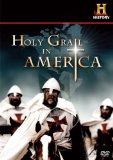| Reviews & Columns |
|
Reviews DVD TV on DVD Blu-ray 4K UHD International DVDs In Theaters Reviews by Studio Video Games Features Collector Series DVDs Easter Egg Database Interviews DVD Talk Radio Feature Articles Columns Anime Talk DVD Savant Horror DVDs The M.O.D. Squad Art House HD Talk Silent DVD
|
DVD Talk Forum |
|
|
| Resources |
|
DVD Price Search Customer Service #'s RCE Info Links |
|
Columns
|
|
|
Holy Grail in America
If it follows that I, like most Americans, learned my world history through the movies, and if you then factor in that Viking and Knights Templar movies are far more entertaining than Christopher Columbus movies, then ergo, ipso facto, logic must dictate that the Templar Vikings founded America. E pluribus unum, or in the common vernacular, "clear as mother's milk." To quote two of the great tiny minds of the 21st century, the time for debate is over, because the science is already settled. History has released Holy Grail in America, a fascinating (if mistitled) look at some of the controversial theories concerning pre-Columbian exploration of America by Templar Vikings (or possibly Templar Knights and Vikings), backed up by theoretical discussions and scientific examinations of the famous Kensington Stone, the Newport Tower in Rhode Island, the Oak Island "Money Pit," the "Westford Knight," the Narragansett Stone, and other artifacts that some scholars believe prove that Columbus Day should be called Henry I Sinclair or Eric the Red Day.
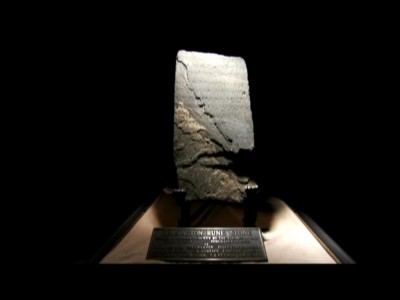
Briefly outlined, Holy Grail in America's research is anchored by the work of geologist Scott F. Wolter, who believes that a "hooked X" rune symbol found on the Kensington Stone is the key link to many other supposedly pre-Columbian artifacts found in America, and that the "hooked X" even extends to Christopher Columbus himself who may very well have had a map to the new world, supplied by his father-in-law: an influential Templar sea captain (Columbus used the "hooked X" in his signature after sailing to America). Beginning with the acknowledgment by most scientists that the Vikings did indeed visit the North American continent around 1000AD, Holy Grail in America then moves to a discussion of the Kensington Stone. In 1898, right outside of Kensington, Minnesota, farmer Olaf Ohman was clearing his newly-acquire farmland of poplar trees when he discovered a large stone tablet embedded in a 40-year-old poplar root system. His young son noticed markings on the tablet, and 25 witnesses supposedly witnessed the stone entangled in the root system before it was dug out. With a nail, Ohman scratched out the dirt covering the rune symbols, and the rest is history (or hoax), as scholars and scientists have debated the authenticity of the stone ever since.
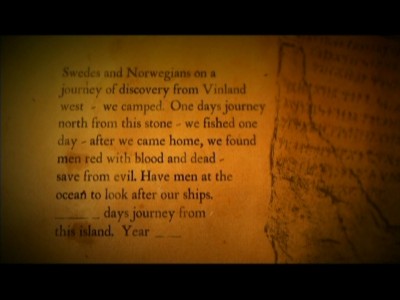
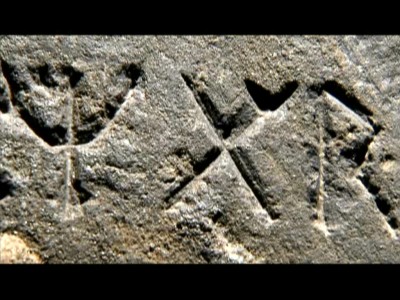
And there's good reason to debate the stone's historic worth because, written in what some believe is a rare 14th century Swedish rune dialect, the stone purports to tell a brief account of explorers coming to this land for "discovery," with some of their party either massacred by indigenous people, or dying off from the plague. And here's the kicker: the stone is dated 1362 - 130 years before Columbus sailed the ocean blue (as we all know from the Bugs Bunny song). Geologist Wolter then discusses the science that leads him to believe the stone is an authentic 14th century carving (it has to do with mica flakes). The documentary moves on to a brief look at some Templar history, including an intriguing (yet too brief) discussion of the possibility that Templars, possessing the Holy Grail (or some Christian relics or secrets of unimaginable power and worth), sailed to the best hiding place in the world: America (which everybody knew was out there anyway, despite the mythology that Columbus stumbled on to it by accident). The documentary returns to Wolter and his discovery of the "hooked X" on the Kensington Stone, along with a discussion of its double dating (via the Easter Table), and how those runes correctly line up with the year 1362. A new translation of the stone is then put forth, with the critical word change from "discovery" to "acquisition," which gives rise to Wolter's theory that the Norsemen (along with either Templars or possibly Cistercians) were in America for exploitation, not exploration, and that the Kensington Stone is really a "land claim" marker for the purposes of further voyages and settlement (which may have been cut off by the outbreak of the Plague in Europe). A brief discussion of some artifacts found in Little Egypt in Southern Illinois is made, before Prince Henry I Sinclair's supposed voyage to Nova Scotia (and possibly America) in 1398, and his influence on the indigenous Mi'kmaq tribe (who may very well have adapted him to their god, while acquiring Templar symbols for their own...just check out their native flag, man. Pretty crazy coincidence.). The doc then moves on to brief looks at the Oak Island "Money Pit," the "Westford Knight," the Spirit Pond stones in Maine, the Narragansett Stone, and the Newport Tower (Great-grandfather Benedict Arnold's windmill? I think not), with a parting shot at Chris Columbus, theorizing he had a map to the new world, supplied by his sea captain father-in-law...who was a Templar.
Growing up in the early-to-mid 70s - the Golden Age of so-called "pseudo-science" (a term of identification, not judgment) and popular mythologizing of paranormal phenomenon like UFOs, Bigfoot, the Loch Ness Monster, the Bermuda Triangle - you couldn't escape the feeling that beneath the surface of that pedestrian world your teachers and parents discussed (math problems, Nixon, gym class, gas rationing, Vietnam, pet rocks), there was a whole other shadow world out there filled with strange, exciting occurrences and marvels, waiting to be discovered out in the oceans, or forests, or deserts, or lonely, rural backroads. It was an exciting time to be a kid (until disco came and killed off the rest of the century), and of course, anytime a movement in popular culture is detected, artists and moneymakers move to cash in, with movies, TV shows, books, magazines, records, t-shirts, posters, and whatnot churned out to capitalize on the growing "pseudo-science" phenoms. I can now proudly point to the various Schick Sunn Classic posters that adorn my office (I'm still waiting for a DVD boxed set, fellas), while one of my favorite TV series at that time, the syndicated In Search Of..., with Mr. Spock himself, Leonard Nimoy, still runs through my head whenever I watch one of these speculative history docs from History.
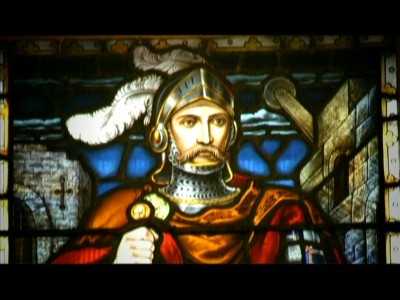
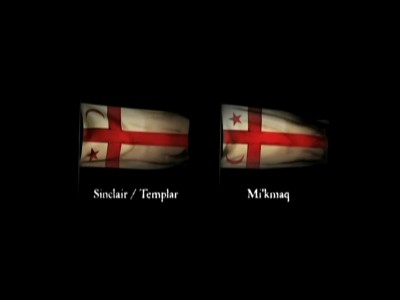
To be clear, I'm not equating the work of geologist Scott Wolter with Bigfoot researchers (I wouldn't do that to my worst enemy), but since the 80s, when science started to be a drag (Chernobyl), and now with the death of science altogether (since we now apparently have the first scientific theory in history - this so-called "global warming" - that no longer needs investigation or even proof to be declared correct, with doubters cast as heretical dolts), it's fun to speculate with docs like Holy Grail in America, particularly when the evidence seems so tantalizing and plausible. Now let's be honest: nobody really knows what the hell the Knights Templar did once they were run out of Europe by France's King Philip IV's and Pope Clement V's decimation of the Order in 1307. There are a lot of theories out there, but no one can say with any degree of certainty. So don't get sniffy if someone connects the dots and postulates that they boarded their fleet of ships and came here to America, where nobody would find what they buried, or if the Templars moved to Scotland, and aided Prince Henry I Sinclair in his voyage to America (there sure are a lot of Templar-looking symbols on all those rocks around the East Coast). Did they bring the Holy Grail to America? You might think this documentary, considering its title, would at least discuss the possibility (unfortunately, it doesn't, hence the title being a bit of a cheat). In the end, they're all just theories, subject to change with further investigation (unless the Goracle gets ahold of 'em), so don't get your nose out of joint. If you think nobody else knew about that huge land mass waiting to be called North America prior to Columbus somehow stumbling upon it, that's cool. You're in good company with probably most people. We do know, however, that the Norsemen did hit Greenland way before Columbus hit the West Indies...and maybe points south along what is now the American East coast, so it's implausible they didn't tell someone about this feat, or that someone didn't find out? The doc mentions very briefly (one sentence, actually) that the mythology of no one knowing North America existed prior to Columbus, came about in the 18th century. That would seem to be a key point to many other theories presented in the doc: did people know about North America prior to Columbus, and when did they know it? Unfortunately, no further explanation of that mythology is offered here.
As for the doc's central examination of the Kensington Stone, it sure seemed plausible. Of course I'm no linguistics expert, so Swedish rune dialects are Greek to me. But again, the doc is careful to point out that nobody agrees on the various translations of the Stone, so it's just one expert's opinion versus another (and what's with that snippy anthropologist here whose words drip with scorn every time he discusses the Stone? Relax, pal - it's not life or death.). Wolter's "hooked X" theory has that marvelous pull of all those seemingly miraculous "plain as the nose on your face" discoveries in science, once you connect all the dots (of course, whether or not connecting the dots is legitimate is the whole question). But it certainly makes for a plausible, believable scenario: what would have stopped explorers and exploiters with Templar aid from reaching the New World when Vikings had already done so 300 hundred years before? As for Wolter's science, tellingly, the doc never presents any other geologists who have alternative theories about Wolter's findings. However, Wolter's science seems solid (he discusses the loss of mica from the stone, ultimately coming to the conclusion that the engraving marks are far older than 1898, thus eliminating a hoax). Once the doc moves towards connecting up the Newport Tower (it's an astrological temple, to be sure) with the Kensington Stone (amazingly, if you connect up the astrologically-aligned windows in the Tower, they point, 1500 miles away, directly to Kensington), all those memories of In Search Of..., In Search of Noah's Ark, In Search of Historic Jesus, and The Lincoln Conspiracy came flooding back (god, do I miss Brad Crandall's voice), selling me on this whole "hooked X," Knights Templar Vikings, pre-Columbian America discovering theory. And quite frankly, who cares if it's true or not? It's fun.
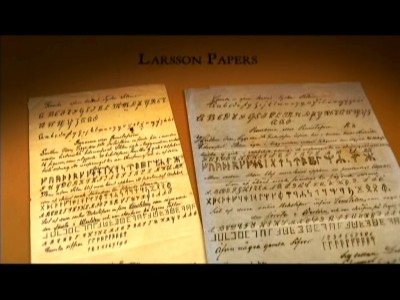
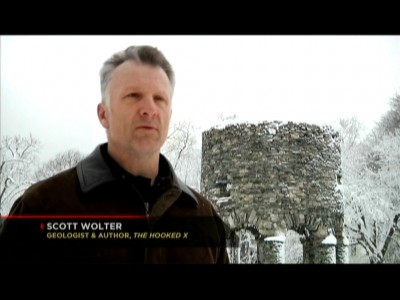
The DVD
The Video
Holy Grail in America is presented, unfortunately, in a non-anamorphic, 1.78:1 letterboxed transfer that looks reasonably bright and sharp, with no significant image anomalies, but with the ever-present interlacing factor we always see with these History docs (lots of jaggies in the transitions). Colors are strong and correctly valued. Overall, a nice transfer (but a smaller monitor helps). Seriously, History, get with the program: anamorphic transfers, fellas.
The Audio
The Dolby Digital English 2.0 stereo audio mix is entirely adequate for this largely dialogue-driven doc. Recording levels are strong, and hiss is minimal. Close-captions are said to be available, but on all of my equipment, they inexplicably came and went throughout the program (as with most of these History docs, for some strange reason).
The Extras
There are no bonuses for Holy Grail in America.
Final Thoughts
Do I need to have Christopher Columbus remain the "discoverer" of America? Let's put it this way: have you ever seen 1492? I didn't need the Kensington Stone to tell me that story stunk. Jeeee-suz. Holy Grail in America may be mistitled (the Grail - whatever it may have been - hardly figures in), but there are some fascinating dots connected here for those new to the Templar/Viking/pre-Columbian American voyages theories. I recommend Holy Grail in America.
Paul Mavis is an internationally published film and television historian, a member of the Online Film Critics Society, and the author of The Espionage Filmography .


|
| Popular Reviews |
| Sponsored Links |
|
|
| Sponsored Links |
|
|
| Release List | Reviews | Shop | Newsletter | Forum | DVD Giveaways | Blu-Ray | Advertise |
|
Copyright 2024 DVDTalk.com All Rights Reserved. Legal Info, Privacy Policy, Terms of Use,
Manage Preferences,
Your Privacy Choices | |||||||









